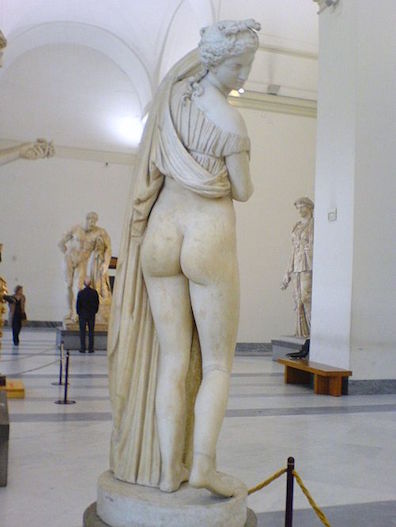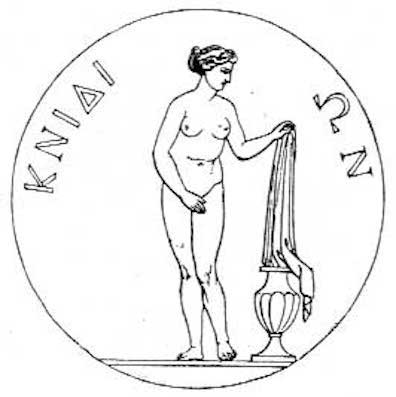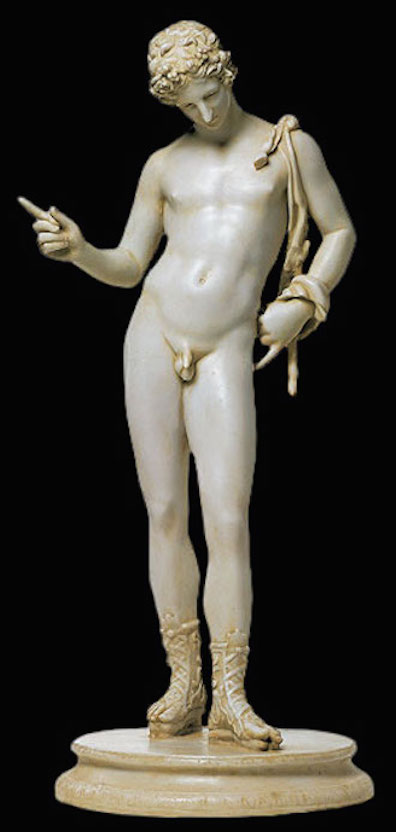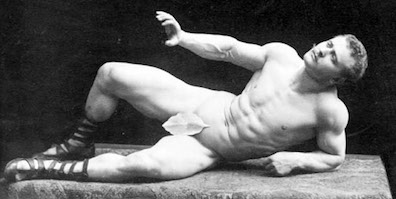In 1904 the National Museum, located across a courtyard from
the externally identical National
Library, displayed 77 plaster casts of famous Greek and
Roman statues in its entrance rotunda. One of these plaster
reproductions was of some imitative version of Praxiteles'
Venus, a very famous lost work of the 4th century BCE in which
the goddess modestly covers her private parts with her right
hand. It seems that the museum also displayed a copy of the
Venus Callipyge or Kallipygos, a less demure work from the 1st
or 2nd century BCE in the which the goddess lifts her tunic to
give the audience a good view of her buttocks.
In "'Museum With Those Goddesses': Bloom and the Dublin
Plaster Casts," Dublin James Joyce Journal 2 (2009):
24-38, Fintan Cullen observes that "On the evidence of a
contemporaneous photograph from the William Lawrence studio of
the interior display in the Dublin Museum’s rotunda, the
placement of the cast against the wall of the rotunda would
not have allowed Bloom much room in which to explore what
Mulligan, a medical student, refers to as her ‘mesial groove’
(she is seen in the back row of the display of casts, with her
left arm raised)." Nevertheless, the novel asks us to imagine
Bloom squinting between the goddess's buttocks to see if the
sculptor has bothered to include an anus.
His quest originates in Lestrygonians, when he
thinks about the differences between mortal and divine diets:
"Shapely goddesses, Venus, Juno: curves the world admires.
Can see them library museum standing in the round hall,
naked goddesses. . . . Quaffing nectar at mess with
gods golden dishes, all ambrosial. Not like a tanner
lunch we have, boiled mutton, carrots and turnips, bottle
of Allsop. Nectar imagine it drinking electricity: gods' food.
Lovely forms of woman sculped Junonian. Immortal lovely. And
we stuffing food in one hole and out behind: food, chyle,
blood, dung, earth, food: have to feed it like stoking
an engine. They have no. Never looked. I'll look
today. Keeper won't see. Bend down let something fall see if
she."
At the end of Oxen of the Sun someone in the crush
of the bar crowd, quite possibly Stephen Dedalus, mentions "Venus
Pandemos," another avatar of the goddess whose name
means Venus of All the People. Aphrodite Pandemos was
sometimes seen as the goddess of all Greece, but she was also
the goddess of sexual delights and prostitution, as opposed to
the "heavenly" Aphrodite Urania—and so the lusty young man's
remark seems to anticipate coming adventures in the red light
district. Venus Pandemos and her sister of the beautiful
buttocks are mentioned together in Circe, as Bloom "explains
to those near him his schemes for social regeneration. All
agree with him. The keeper of the Kildare Street Museum
appears, dragging a lorry on which are the shaking statues
of several naked goddesses, Venus Callipyge, Venus
Pandemos, Venus Metempsychosis, and plaster figures, also
naked, representing the new nine muses."
In advocating for "social regeneration" through appreciation
of classical sculpture, Bloom finds common cause with Buck
Mulligan's program of "Hellenising"
Ireland. In Oxen of the Sun, these two men of
science discuss infant mortality and Mulligan envisions a role
for statuary in promoting the health of expectant mothers and
their babies: "Kalipedia, he prophesied, would soon
be generally adopted and all the graces of life,
genuinely good music, agreeable literature, light philosophy,
instructive pictures, plastercast reproductions of
the classical statues such as Venus and Apollo,
artistic coloured photographs of prize babies, all these
little attentions would enable ladies who were in a particular
condition to pass the intervening months in a most enjoyable
manner."
Bloom himself owns "an image of Narcissus
purchased by auction from P. A. Wren, 9 Bachelor's Walk (Ithaca)"—a
"little statue," Bello notes, that "you
carried home in the rain for art for art's sake" (Circe).
Bloom derives no prurient pleasures from this male statue, but
his wife does: "those fine young men I could see down in Margate strand bathing place
from the side of the rock standing up in the sun naked like a
God or something and then plunging into the sea with them why
arent all men like that thered be some consolation for a woman
like that lovely little statue he bought I could look
at him all day long curly head and his shoulders his finger
up for you to listen theres real beauty and poetry for you
I often felt I wanted to kiss him all over also his
lovely young cock there so simple I wouldnt mind taking him
in my mouth if nobody was looking as if it was
asking you to suck it so clean and white he looks with his
boyish face." Somewhere in the course of this reverie the
small statue merges in Molly's mind with Stephen Dedalus.
The sexual desire that these statues excite in Bloom,
Stephen, and Molly, together with Bloom's desire to imitate
the standards of male beauty embodied in Eugen Sandow's exercises, make clear
that by the time Joyce wrote his "epic of the body" he had
reconsidered some of the aesthetic ideas voiced by Stephen in
A Portrait. In part 5 of that work, Stephen tells
Lynch that the emotions excited by art should be "static,"
i.e. not moving one to action. The "desire and loathing"
excited by pornographic or didactic works are "unesthetic
emotions not only because they are kinetic in character but
also because they are not more than physical."
A lusty Lynch plays the devil's advocate: "You say that art
must not excite desire, said Lynch. I told you that one day I
wrote my name in pencil on the backside of the Venus of
Praxitiles in the Museum. Was that not desire?" Stephen
dismisses this reaction: "your flesh responded to the stimulus
of a naked statue but it was, I say, simply a reflex action of
the nerves." He advocates instead an Aquinian understanding of
beauty as "the splendor of truth," and uses Darwin as a straw
man to debunk the notion that the beauty men see in women can
be explained solely by desire for "the propagation of the
species." Lynch professes himself convinced when Stephen
ridicules the idea that "you admired the great flanks of Venus
because you felt that she would bear you burly offspring and
admired her great breasts because you felt that she would give
good milk to her children and yours."
By the time he wrote Ulysses Joyce clearly had
thought better of Stephen's overly neat dichotomy between the
physical and the spiritual. The statues in the mature novel
engage characters' emotions in much more kinetic ways. In this
connection it is worth mentioning that Praxitiles' lost Venus,
which would have been painted, was reportedly so
extraordinarily mimetic that, despite its modest pose and its
function as a sacred temple statue, it aroused some ancient
Greek men. Section 15 of the Erotes (a Greek
dialogue written in the time of the Roman empire) tells the
story of a young man who broke into the temple at night,
"embraced" the statue (to use Molly's language), and left a
stain on it.



